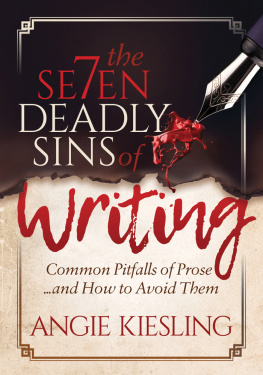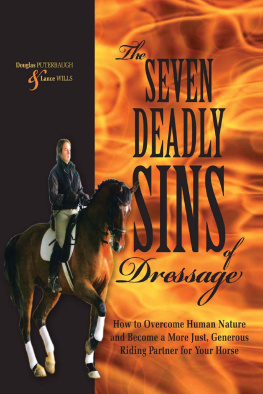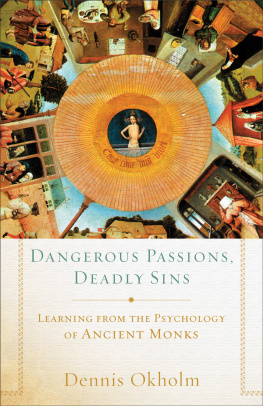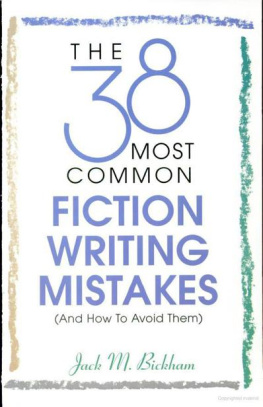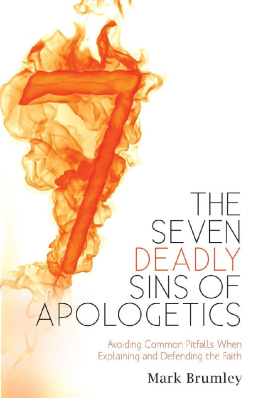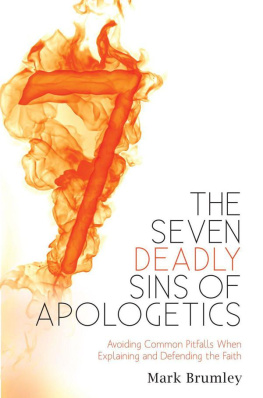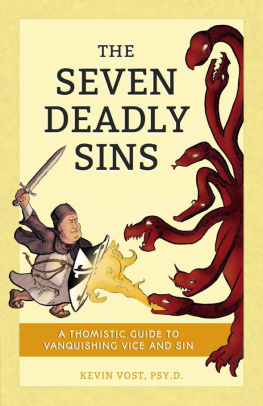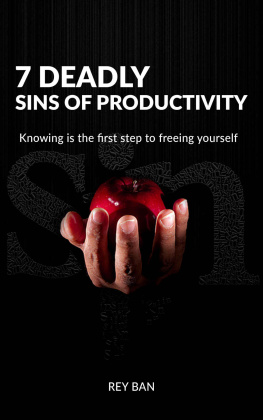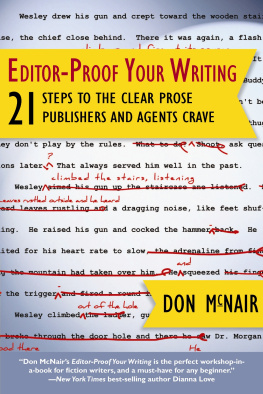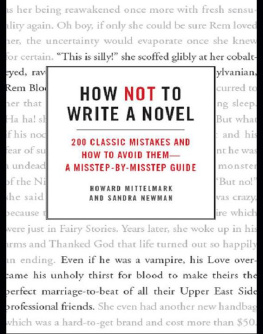Common Pitfalls of Prose
and How to Avoid Them
Angie Kiesling
THE 7 DEADLY SINS OF WRITING
Common Pitfalls of Proseand How to Avoid Them
2018 Angie Kiesling
All rights reserved. No portion of this book may be reproduced, stored in a retrieval system, or transmitted in any form or by any meanselectronic, mechanical, photocopy, recording, scanning, or otherexcept for brief quotations in critical reviews or articles, without the prior written permission of the publisher.
Published in New York, New York, by Morgan James Publishing. Morgan James is a trademark of Morgan James, LLC. www.MorganJamesPublishing.com
The Morgan James Speakers Group can bring authors to your live event. For more information or to book an event visit The Morgan James Speakers Group at www.TheMorganJamesSpeakersGroup.com.
ISBN 9781683506850 paperback
ISBN 9781683506867 eBook
Library of Congress Control Number: 2017911645
Cover Design by: Rachel Lopez www.r2cdesign.com | Interior Design by: Chris Treccani www.3dogcreative.net |

In an effort to support local communities, raise awareness and funds, Morgan James Publishing donates a percentage of all book sales for the life of each book to Habitat for Humanity Peninsula and Greater Williamsburg.
Get involved today! Visit www.MorganJamesBuilds.com
If Writing Were Baking
How to Use This Tiny Tome
If you were a baker, across three decades of baking youd have seen a lot of crescent rolls, right? Youd know the recipe so well you could probably bake those rolls in your sleep.
When I hit my third decade in the publishing business as a writer and book editor, I realized I could spot most bread-baking mishaps at fifty paces. Maybe, just maybe, other writers might benefit from the discipline Id learned across the years, I reasoned.
Wanting to keep things light, I borrowed a concept from the Middle Ages, likening the seven most common pitfalls of prose to the 7 Deadly Sinsor Donts, as theyre referred to in this tiny book.
Tiny is a key word here because I know youre stretched for time. We all are. Quick reads are good, allowing you to get in and get out, takeaway in tow. Consider this book a list of seven things NOT to do when writing (each entry flips the title on its head so you know exactly what TO DO for best writing resultsthese are called Divine Dos).
If you freefall into one of the Donts the next time you sit down to write, no worries: I promise you wont wind up on a ledge in Purgatory. Theres still time to redeem your prose. Every time you practice the craft of writing, your skill increases.
Notice I said craft; writing is just that. Historically speaking, it took years for a journeyman/apprentice to reach the level of a master craftsman, but you can shorten the distance as a writer by following the example of great writers. The more you read great writing, the better writer you will become.
A Little Leaven, Anyone?
As youll soon see, most of the items in my Deadly Donts list are perfectly good words and phraseseven parts of speechthat every writer uses when they compose text. The key is in their usage and frequency. Its been said that a little leaven leaveneth the whole lump; keep that in mind as you sift through the Deadly Donts. For bread bakers, leaven is a necessary ingredient. But throw too much leaven into the mix and youll have a big mess on your hands. The recipe requires just the right touch.
Another thing worth mentioning up front is that all writers have a distinct voice (if you havent found your voice yet, keep writing; it will emerge over time). Some of the Deadly Donts may seem to imply that all writers must write the same way. Of course they dont. Good writing allows for different styleslyrical (think Fitzgerald); punchy and staccato and lean (Hemingway); complex and psychological (Joyce Carol Oates); stream-of-consciousness (Virginia Woolf)... and thats only a sampling. Yet all four are revered as great writers. While their writing is fiction, the advice in this book applies to nonfiction writing as well.
Its equally true that writing changes over the course of decades and centuries, and reading tastes change too. Most readers today expect your words to work a lot harder than, say, those of an author one hundred-plus years ago. Im guilty of this myself. As much as I love a good Dickens tale, Id be hard-pressed to struggle through all 716 pages of Little Dorrit my favorite of his stories adapted for film (miniseries), but famous for being a hard read.
My advice: take the Deadly Donts with a pinch of salt. The reasoning behind this little book is that I see so many manuscripts, both fiction and nonfiction, falter for the very reasons stated below. With a keen eye and a little practice, you can train yourself to turn the Deadly Donts into Divine Dosand perhaps create your own test-of-time-worthy prose.
Ive intentionally written this book using everyday language and refrained from stuffing it with grammar rules. If I succeeded in my goal, that approach will make it more readable.
Whether youre just starting down the road marked WRITER or a seasoned pro revisiting the basics, I hope The 7 Deadly Sins of Writing reminds you, all over again, of what makes writing so wonderful.
So here, at a glance, are the 7 Deadly Sins of Writing:
Are you ready to get started? Lets go!

The Deadly Donts
The best piece of advice I can give you as a writer is to learn to self-edit your work, and these 7 Deadly Sins of Writing are my top picks for how to do that. With a little practice, you can train your eye and your writing instincts to do these seven things automatically. Before too long theyll become second nature, and youll wonder why you ever wrote any other way.

Deadly Dont #1
Passive Voice
Use Active Voice. Teach yourself to write in active voice rather than passive voice. Why? Because it makes the difference between strong writing and weak writing. If you need a more practical reason, here are two. Agents reject manuscripts loaded with passive voice. And readers find active voice engaging. Stories told in active voice carry the reader along with the action and involve the reader in the action.

